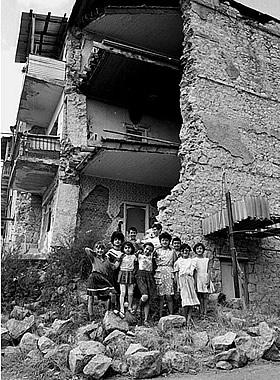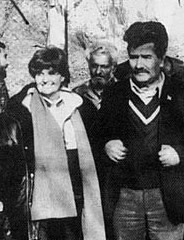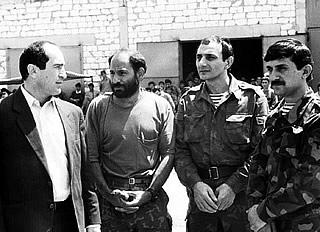History of Karabakh (part 4)
Independence of NKR proclaimed
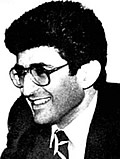 Artur Mkrtchyan, elected First President of NKR Parliament at age 33, tragically died just 3 months later under mysterious circumstances.
Artur Mkrtchyan, elected First President of NKR Parliament at age 33, tragically died just 3 months later under mysterious circumstances.
In the face of forthcoming Azeri aggression and inevitable collapse of the Soviet Union, the leaders of Artsakh understood the necessity of founding their own statehood in Artsakh. This decision, though opposed to the unanimous popular will to incorporate the region with Armenia, allowed ensuring the security of the population in an optimum way. On September 2, 1991 a joint session of deputies of Nagorno-Karabakh and the Shahumian region voted for an independent Nagorno-Karabakh Republic. On December 10, 1991 the overwhelming majority of Armenians of Nagorno-Karabakh and the Shahumian region voted for independence in the referendum held in presence of international observers and Human Rights watch. On January 6, 1992 the Nagorno-Karabakh Republic (NKR) was officially proclaimed, and on the next day, Arthur Mkrtichyan was elected Chairman of the NKR Parliament.
Azerbaijan begins military actions
From December 1991, the Azerbaijani forces deployed large-scale military operations against Artsakh. The Azeri-populated areas, especially Shushi and Hodjallu were quickly converted into mighty military bases, from which artillery and rocket launchers began systematic bombing of Stepanakert and the surrounding Armenian villages. The “Grad” projectile banned by many international conventions as a weapon of mass destruction was widely used by Azeri military. The twenty-four-hour a day bombing and shelling caused hundreds of deaths and turned the life of Stepanakert residents into nightmare. The Armenians took shelter in basements. Many establishments and institutions, including hospitals and maternity homes also relocated in basements.
First Armenian victories
The Azeri regular forces, heavily superior in men and machines, began a large-scale offensive in the beginning of 1992. In the early stages of the war, the small groups of Armenian volunteers called Fedayi played the major role in defending the Armenian border villages. However, the growing Azeri aggression necessitated reorganizing the Armenian Fedayi brigades into an effective force under united command. In January of 1992, the special Headquarters was formed to coordinate the defense forces of Artsakh. During the following weeks, the Armenians won their first serious military victories in Stepanakert-adjacent villages of Kirkijan, Malibeyli and Ghushchilar.
Liberation of Khodjalu, Shushi and Lachin
After the elimination of Azeri bridgeheads near Stepanakert, the liberation of Khodjalu became the primary task, as the Azeri forces concentrated in this large village considerable manpower and military equipment. Also, that would allow regaining control over the airport, located in Khodjalu.
The operation started on February 25, 1992, when the Armenians took up the positions in the west of Khodjalu. The enemy was offered to surrender the village while a humanitarian corridor for the civilians was established. Conversely, the Azeri commandment resumed the military actions, using the Azeri civilians as a shield. On February 26, Khodjalu was liberated, which finally allowed the normal functioning of the airport.
However, from the city of Shushi, towering above Stepanakert and converted into a mighty military base, intensive bombardment continued day and night, causing many casualties. The Armenian military commandment decided to eliminate the firing points throughout Artsakh. Thus, the liberation of Shushi became vital necessity. Because of its unique geographic location, Shushi was always considered inaccessible fortress. There is even an old saying: Who controls Shushi, controls Karabakh.
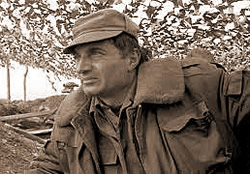 Arkady Ter-Tadevossian, nicknamed Commando, during the Shushi operation, in May 1992. The Shushi operation began on May 8, 1992. First, the Armenian forces under Arkady Ter-Tadevossian gained control over Shushi-Lachin road. Then, following an onslaught from the northeast, they broke through the Azeri defense line. After street fighting on May 9, the defeated Azeri troops finally left the city. Continuing the offensive, the Armenians gradually liberated the all-important strong points along the Shushi-Lachin-Zabuh road, and, on May 18 they took the town of Lachin. Thus, after the 3-year blockade, a land bridge linking the Republic of Armenia with the NKR was reestablished.
Arkady Ter-Tadevossian, nicknamed Commando, during the Shushi operation, in May 1992. The Shushi operation began on May 8, 1992. First, the Armenian forces under Arkady Ter-Tadevossian gained control over Shushi-Lachin road. Then, following an onslaught from the northeast, they broke through the Azeri defense line. After street fighting on May 9, the defeated Azeri troops finally left the city. Continuing the offensive, the Armenians gradually liberated the all-important strong points along the Shushi-Lachin-Zabuh road, and, on May 18 they took the town of Lachin. Thus, after the 3-year blockade, a land bridge linking the Republic of Armenia with the NKR was reestablished.
Elshibey launches new offensive
 Abulfaz Elchibey Meanwhile, the leaders of Azerbaijan planned a new large-scale offensive. Abulfaz Elchibey, leader of the Popular Front now elected President of Azerbaijan, declared the rapid military victory in Karabakh his major objective. The Azeri leadership made financial arrangement with commanders of the former Soviet 23-d division of the 4-th Army, winning over a large number of Russian officers, especially in the Tanks.
Abulfaz Elchibey Meanwhile, the leaders of Azerbaijan planned a new large-scale offensive. Abulfaz Elchibey, leader of the Popular Front now elected President of Azerbaijan, declared the rapid military victory in Karabakh his major objective. The Azeri leadership made financial arrangement with commanders of the former Soviet 23-d division of the 4-th Army, winning over a large number of Russian officers, especially in the Tanks.
 Shahen Meghrian, commander of the defense forces of the Shaumian region. On June 12, 1992 Azeri infantry supported by many Russian Tank corps launched an unprecedented offensive on the Shahumian region. During the next week, Azeri forces succeeded in taking control over the Shahumian region, and also occupied most of the Mardakert region. Some 40,000 refugees fled to Stepanakert, while small groups of the Shahumian fighters led by Shahen Meghryan were trying to penetrate into the occupied areas to wage guerrilla warfare.
Shahen Meghrian, commander of the defense forces of the Shaumian region. On June 12, 1992 Azeri infantry supported by many Russian Tank corps launched an unprecedented offensive on the Shahumian region. During the next week, Azeri forces succeeded in taking control over the Shahumian region, and also occupied most of the Mardakert region. Some 40,000 refugees fled to Stepanakert, while small groups of the Shahumian fighters led by Shahen Meghryan were trying to penetrate into the occupied areas to wage guerrilla warfare.
Half of Karabakh under Azeri occupation
As the danger of further Azeri advances persisted, the NKR Parliament declared a state of emergency. The situation worsened to impending disaster when the Armenian defenders retreated from Mardakert and Aterk, on July 5, 1992. The whole Mardakert region was embroiled in combats. At the same time, the Azeri troops tried to break through the Armenian positions in Askeran, Martouni and Hadrout regions.
On August 12, as half of the NKR territory fell under the Azeri occupation, the NKR Parliament decreed marshal law and the mobilization of 18-45 year-olds. On August 15, the State Defense Committee of the NKR was formed, and Robert Kocharyan became its Chairman with emergency powers.


